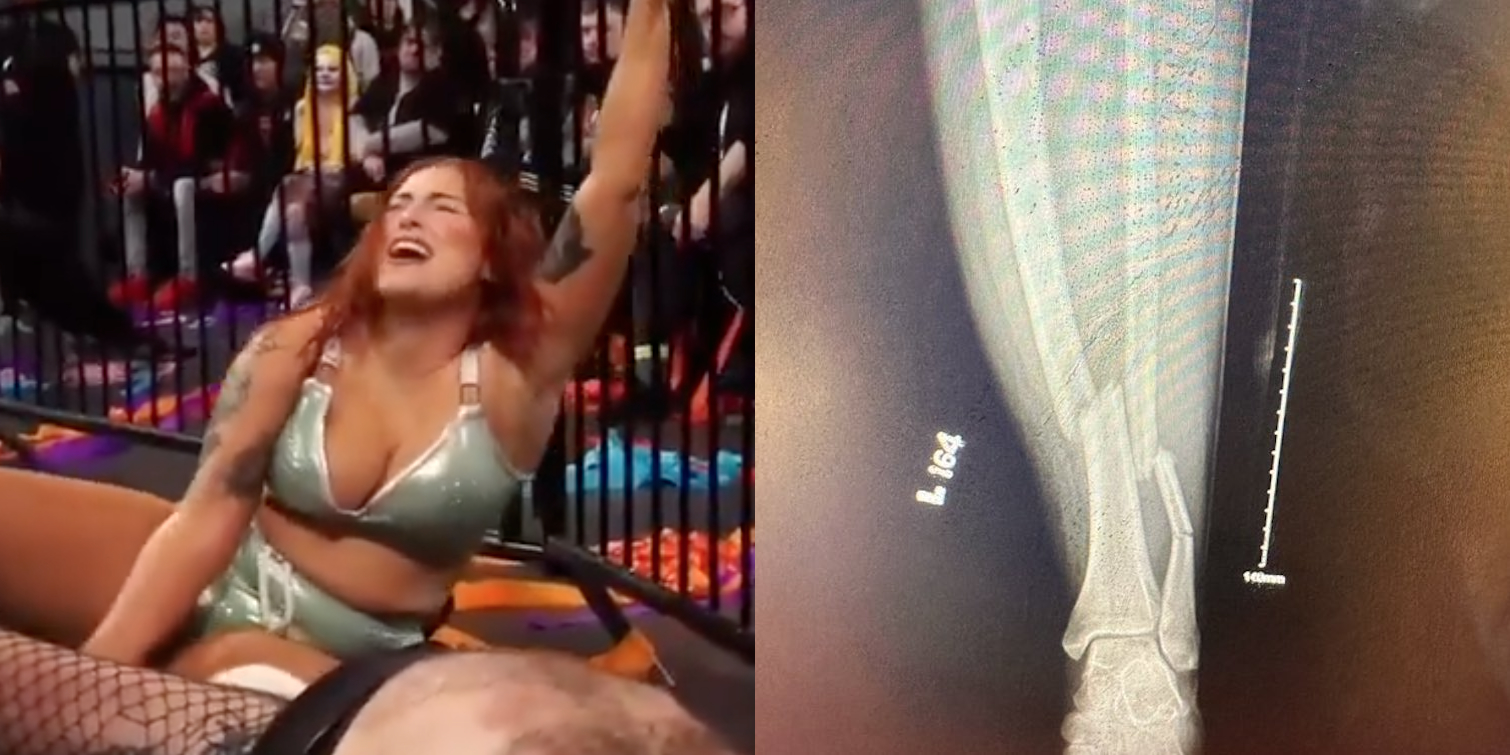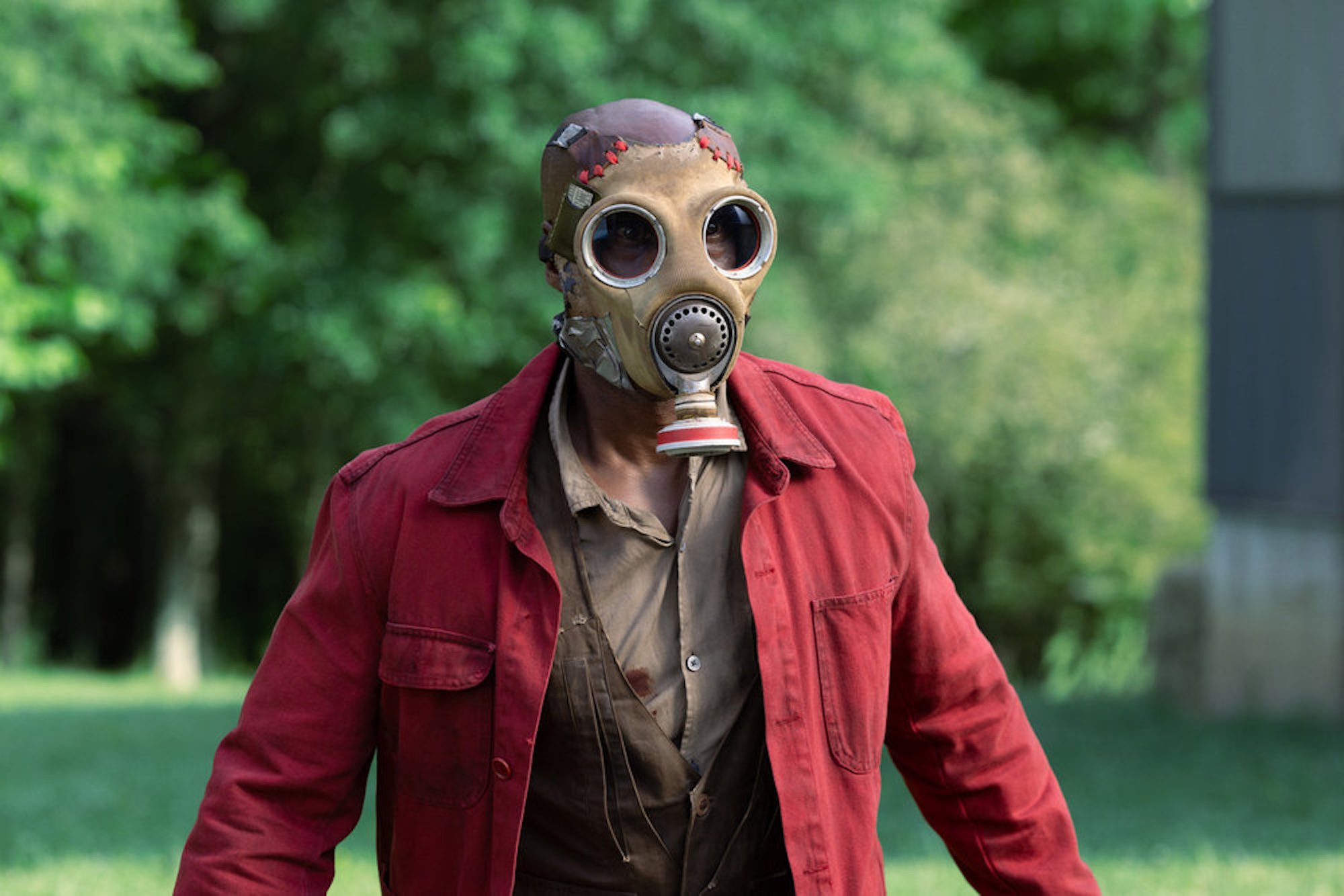About to Break: The Creation of Linkin Park’s “One Step Closer”
On Tuesday, author Jason Lipshutz will release his new book, It Starts With One, from Hachette Books. Below is an excerpt of the chapter on the song “One Step Closer.”
There was simply no way that the tension wasn’t going to spill over into the music. The years of forming, reconfiguring, swapping singers, changing names, garnering intense doubt from the industry, and now sowing seeds of uncertainty inside the studio, on the precipice of something spectacular or maybe nothing at all—it built and built and demanded release.
The band that would become Linkin Park knew this. They could hear their own walls rattling when the coarse, chunky riff of the opening ten seconds of “One Step Closer” exploded into the rest of the song. They could feel hours of frustrated calls and not-quite-right pulling-your-hair-out studio medium melt away when Chester’s voice ripped into the bridge. It’s all there, in every word and scream and drumbeat.
“One Step Closer” is a miracle, a timeless piece of intense beauty and pummeling anger. It’s the type of perfect debut single that any band would love to have but would hate to have to earn.
Hundreds of points of exasperation, the ones that made the band members wince and sigh and shake their heads in the years leading up to their first album, could be felt in the “I’m about to BREAK!” immediacy of “One Step Closer.” But in late April 2000 at NRG Recording Studios in North Hollywood, Chester Bennington and Mike Shinoda were actually about to break.
:no_upscale()/cdn.vox-cdn.com/uploads/chorus_asset/file/25652295/It_Starts_With_One_Cover_Art.jpg)
Hachette
Not with each other, of course—they had formed a symbiotic relationship within the band at that point, and the rest of the group recognized the power of their bond. But producer Don Gilmore, brought in to helm their debut album following the Warner Records label deal, did not. He kept prodding the band to tweak a song that was originally titled “Plaster.” It was good, but it wasn’t quite right.
Incomplete sections needed to be filled out, according to Don. Lyrics needed to be changed, then changed again. As he kept pushing for rewrites, attitudes started to blister to a worrisome point. Chester became so furious with his producer that he started writing lyrics about how furious he actually was—seeing red, then scribbling down every pissed-off word he could squeeze out of his pen.
Chester wanted his ideas to be heard. But more than that, he wanted the person seemingly trying to drown them out to shut the absolute hell up.
Even if everything in the studio had been copacetic, this would have still been a pressure-packed moment for the group, just as it would have been for any band trying to cut through a crowded scene. The demos from the Hybrid Theory EP and its castoffs hadn’t made a dent in scores of label showcases, and the band was still tinkering with ways to combine rap and rock music that felt new yet urgent. The song that would become “One Step Closer”—which Mike and Brad Delson had first pitched as a demo, then the band rerecorded at NRG within the four weeks of creating their first album—had the potential to be their opening statement, a lead single and introduction to something bigger than themselves.
If the band and their producer weren’t seeing eye to eye on how that statement should function, that would have been a simple enough problem to solve: compromise, find common ground, or try another producer on for size. Yet this conflict took place as multiple voices surrounding the band believed that they should change not only a few things about their sound but also the very fabric of their being, as if what made them unique was actually a wrinkle to be ironed out. And from the band’s point of view, the one allowing that chorus of naysayers to creep into the studio—who wasn’t telling anyone floating ideas from the periphery to kick rocks—was their producer.
The band had initially struggled to find a producer for their debut album after signing to Warner Bros. but finally landed on Don Gilmore, a studio veteran in the alternative-rock world. Don had been an engineer on Pearl Jam’s blockbuster-selling Ten album and then produced late-nineties crossover rock hits for bands like Eve 6 and Lit. To put it simply, he was an adult in the room, a technical pro leading a band that was still figuring out studio nuance.
But Don also had a self-admitted blind spot: he had never been involved in making anything that even resembled hip-hop music. And when he signed on to helm the band’s debut album, Don essentially shrugged at half of Hybrid Theory’s sound.
“In choosing Don Gilmore as a producer, we were really hesitant,” Mike explained. “Don had more of these radio-alternative songs, and we knew that he would get that part of our sound right, but he knew nothing about hip-hop. Not a thing! And he said that to us when he met with us. He was like, ‘Here’s the deal, the part of your sound that I can’t contribute to is the hip-hop part. I know that’s a big part of your thing. But I like how you do it, so I will try to just get out of the way in terms of the beats and raps and stuff. I will leave that to you.’”
The band didn’t need a producer telling them to “do their thing” at that point—they needed a champion and defender, someone who recognized the potential of their sound and swatted away creeping doubt about its details. But the executives and A&R reps at Warner Bros. felt similarly to Don: they saw promise in the band, but not in the parts of the band’s identity that skewed toward hip-hop or electronic music. According to these longtime industry men, the rapping in the demos had to be toned down, and the DJ scratching needed to be muted. Ultimately, the band had been signed as a stipulation of Jeff Blue’s employment but still hadn’t proved a damn thing yet, so their identity was considered fungible. And because Don couldn’t explain why those features were essential to the rest of the product, the band realized that he couldn’t quell the anxieties of the suit-wearing cynics.
“In making that record, we weren’t completely understood by the record label, mainly because there was a categorization of what bucket you fit in,” Joe Hahn said. “Being a rock band, but trying to have a firm foundation with our hip-hop and electronic influence that we bring to the music. The formats were alternative rock and active rock at the time. I remember the label at one point asked us to have less rapping and less scratching.”
Once, the band even caught wind of the label’s plan to have Mike stick strictly to the background of the band—or even be replaced by an outside rapper. The argument was that the band had replaced Mark Wakefield with Chester, so why not swap out another perceived weak link for a better MC?
Naturally, those suggestions were met with outrage from the whole band, including Chester. After years of professional instability, he remained loyal to his new band of brothers and waved off attempts to position himself as the sole leader of a traditional hard-rock group.
The truth was, it would have been easy for the band to buckle under the pressure, to feel the weight of the major-label suggestions to streamline their sound into something more digestible, and to cater to a veteran producer who had helped score multiple rock hits. But they never really wanted to be a “traditional hard-rock group” in the first place. Even after Chester joined the lineup and gave them a radio-ready singer, their influences were still a pastiche of hip-hop, industrial, pop, post-punk, electronic, and alternative—everything from Timbaland to Nine Inch Nails to Aphex Twin to Red Hot Chili Peppers—and they were intentionally refracting those sounds through a metal prism. Telling the band to just play straight-ahead hard rock was like telling a running back to never move left or right on the football field; there was never going to be a clear path forward.
Unfortunately, timing was no longer on their side. The group had to work through their debut album in the first half of 2000, a moment when any major label would have viewed rap-rock as a sound that was starting to feel played out on a commercial level. Artists like Korn, Limp Bizkit, Kid Rock, and Staind were still huge, but most of these groups were already experimenting with different sounds and distancing themselves from the nu metal delineation post–Woodstock ’99. The music industry is forever looking ahead for the next big trend, and a rap-rock act named Hybrid Theory undoubtedly felt like a backward glance by the time “One Step Closer” was in the works.
Considering all these circumstances, it makes sense that the band wrote a potential breakthrough song about being at the end of their rope. After so much arduous work and so many iterations, the industry had apparently turned them into an afterthought—that is, unless they were willing to completely change who they were. They were losing the power struggle over maintaining their essence to opinionated A&R reps. And now Don, the producer who couldn’t fully support their vision, was questioning everything about the song still titled “Plaster,” dissecting and disassembling lines to the point of exhaustion.
“We were losing our minds,” Mike recalled. “At that point in the process, it was just like, ‘Why don’t you trust us? This is our album.’ Our A&R guy doesn’t have to have his fucking name on the front of the CD and play this music onstage every day. We knew, if we put anything on this record that we don’t like or that we’re not feeling, we’re gonna have to live with it. Like, this is our career!”
So Chester and Mike balled up that frustration—at Don, at the label, at everything and everyone, but mostly at Don—and hoisted it into what would become “One Step Closer.” The seething, spit-through-the-teeth opening—“I cannot take this anymore / I’m saying everything I’ve said before”—is literally directed at the producer who demanded more rewrites. The chorus cry of “Everything you say to me / Takes me one step closer to the edge” captures their escalating rage. And when it came time to write lyrics for the combustible bridge, Chester needed something pithy and powerful that could silence his biggest critic.
There’s a reason the band considered the song that would turn into “One Step Closer” a potential lead single even before it was completed. Within their early demos and then within the jam-packed hard-rock scene and now within Linkin Park’s whole discography, “One Step Closer” stands out. Every second either boosts the tension or dissipates it in a whooshing release, allowing the listener to translate their own problems onto its baked-in catharsis. Before any vocals are introduced, the instrumentation—quicksilver guitar riff, DJ scratches to suspend it in air, then full-band assault with blistering percussion—moves with kinetic energy and a menace that feels purposeful.
“‘One Step Closer’ is a good representation of the group,” Chester said in 2000, prior to the single taking off, “as far as the riff and the power of the song. The aggression of it.”
As it so happened, the opening guitar riff was a total accident. The band was doing a photo shoot in the underground parking garage of Joe’s apartment building—not a real shoot with a professional photographer, mind you, but a shoot with someone they knew who could capably handle a camera and was up for taking some early band snapshots. Brad was sitting in a car with its door open, bored out of his mind, but fortunately, he had brought his guitar along. He fiddled around with a few licks, then messed with the guitar’s tuning, tweaking the bottom string to a D and working through a few riff ideas.
Brad played a combo in drop D that sounded particularly springy, then played it again, his hands guiding the gleaming bounce across the strings. Mike heard the riff and stopped the faux photo shoot: “I was like, ‘Dude, record that. … Don’t lose that riff!’”
The “One Step Closer” riff musically separated the song from the rest of the band’s demos for their debut album, which were heavy but not necessarily combative. Whereas a song like “Crawling” felt spacious and contemplative in their synthesis of rap-informed hard rock, “One Step Closer” was downright spiky—the sound of a band shoving the general public into the dirt to get its attention.
That sense of confrontation begins with Brad’s sledgehammer of an opening riff but continues coursing throughout the rest of the song. The band wrote “One Step Closer” in Mike’s apartment after the guitar line—played throughout the entire track—was finalized, and the structure came together quickly. Brad’s riff drives the song, but instead of bogging down the arrangement through repetition, the rest of the instrumentation slides into place around it: the sleek cymbal rides on the chorus, the chattering beats expand the arrangement, the scattered DJ scratches dial up the chaos on the bridge. And for everything that sounded modern within the song, the band was smart enough to understand that the age-old quiet-to-loud contrast remained an effective tool: the percussion dropping away before the chorus, then crashing back into view provided a sense of movement, as if Chester and Mike were in cruise control before slamming down the gas pedal.
When the band was recording their debut album, Jeff told Chester that he thought “Crawling” was their surefire smash, a perfect distillation of their softer and harder edges. But Chester wasn’t so sure. He told Jeff that, for one, “Crawling” was more difficult to sing, and two, Mike wasn’t featured on the vocals that much—at least, not as much as he was on a song like “One Step Closer,” which still had the working title “Plaster.”
Chester was singing lead on both tracks, but “Crawling” featured a few quick rhymes from Mike on the pre-chorus, whereas the song that would become “One Step Closer” braided their vocals together on the hook—Chester’s furious howl overlapped by Mike’s quick-jab rapping. The two cadences balanced each other out sonically, volleying the song’s intensity back and forth. Lyrically, they finish each other’s thoughts: Chester sings, “Everything you say to me …,” then Mike swoops in with “takes me one step closer to the edge, and I’m about to BREAK!” And as an opening statement, what better way to introduce your band to the world—and push back against the label execs dissuading your hip-hop influences—than to hoist up the song exemplifying the dual sides of Hybrid Theory?
The fiery lyrics that Chester conjured in the studio after Don kept crumpling up his words and telling him to find more ultimately helped turn the song into an anthem. Because Chester was so livid with his producer and just wanted to hit upon something that worked, each line that made the cut is purposefully straightforward—no frills, just raw emotion.
As such, the lyrics possess a sort of blunt-force universality that can be adopted for any at-wit’s-end scenario. The second verse goes, “I find the answers aren’t so clear / Wish I could find a way to disappear / All these thoughts they make no sense, I find bliss in ignorance / Nothing seems to go away, over and over again.” The song is ostensibly about Chester being fed up in the studio, but most people listening to the song don’t know its backstory, so to them, the words represent the general experience of banging your head against the wall while nothing around you changes. Turns out, that’s a feeling millions of listeners could relate to. In any scenario, the lyrics worked.
But the song still needed a bridge, and nothing Chester or Mike came up with met Don’s standards. Mike imagined a part like the breakdown of Rage Against the Machine’s “Killing in the Name”—that “Fuck you, I won’t do what you tell me!” refrain—fitting into one of the band’s songs and thought something like that might work for the bridge here. The problem was that he just couldn’t find the right words, and their producer kept telling him and Chester to keep trying.
Chester was fuming at Don, to an almost inconsolable point. He jotted down the words “shut up” just to privately vent. Mike loved it. What if that was the bridge? It was simpler than anything he and Chester had come up with so far, but simple might be what the passage required. Chester thought about it for a moment, then agreed.
Chester and Mike entered the studio and told Don to pull up the track—they were ready to record the bridge. “Don was like ‘Well, tell me what it is,’” Mike recalled later with a laugh. “And we go, ‘No, no, no, it’s better if we just record it. Listen to it in its full concept.’”
So Chester entered the vocal booth, and Don cued up the track without knowing what his singer was about to sing. Weeks of tension, months of hard work, years of willing this into reality had all built up to the moment in which Don pressed play—and Chester proceeded to breathe fire.
SHUT UP WHEN I’M TALKING TO YOU!
Shut up! Shut up! SHUT UP!
SHUUUUUT UUUUUPPPP!!!
In the wrong hands, “One Step Closer” could have sounded like a temper tantrum, an ill-conceived expression of angst that landed flat on its face. The song also could have been perceived as a lesser version of similar hard-rock tracks. After all, Limp Bizkit had sung about wanting to “Break Stuff” a year before Linkin Park’s “I’m about to BREAK!” hook. And a few weeks before “One Step Closer” was recorded, Papa Roach had released “Last Resort,” a similarly intense rap-metal opus that served as that band’s mainstream breakthrough.
Betting on “One Step Closer” as the band’s de facto introduction hinged on the belief that the song possessed the gravity to be taken seriously and enough personality to distinguish the band in a packed field. Once that bridge was recorded, though, any lingering uncertainty was laid to rest, and the decision to go with “One Step Closer” was a no-brainer. The song wasn’t like anything else out at the time, because it was better than everything else out at the time.
“Everyone agreed that was the first single,” Mike said. “When you got to the ‘shut up’ part in the bridge, we all felt like, ‘People are going to remember this band when they hear the song.’”
“One Step Closer” not only contained the force to shake radio listeners and CD buyers awake but also appealed to ticket buyers. After the song was fully recorded—it’s the only song on the band’s debut album that features bassist Scott Koziol, who was brought in after Hybrid Theory EP bassist Kyle Christner departed the group after a months-long run—and mixed by Andy Wallace in New York, the band started thinking about their first proper tour in support of their debut album. They knew that “One Step Closer” was the type of song they wanted their audience to know by heart, its hooks shouted back at the stage as their fans’ eyes bulged in delight. Anyone who’s ever been to a Linkin Park show where “One Step Closer” serves as the boisterous finale or has selected the song to scream-sing in a karaoke bar knows that it’s fun as hell to sing. Before it was even released, the band knew that, too.
“We didn’t know anything about picking singles,” admitted Rob, “but it was important for us to start off with a heavier and more aggressive song, because it represented the energy of our live show in the most accurate way. Bringing a ton of energy to our live show has always been top priority.”
Before the band could start blasting through the song at their shows, their label told them they needed to yet again change their name and ditch Hybrid Theory. A UK dance group called Hybrid was part of the extended Warner Bros. ecosystem, and the label group couldn’t support both Hybrid and Hybrid Theory.
The guys decided to keep Hybrid Theory as their debut album title, and after a few more naming mishaps—they were almost called Plear and also considered Platinum Lotus Foundation—they settled on Lincoln Park, an homage to a community space in nearby Santa Monica. They wanted to be a little easier to find online, though, so they tweaked the spelling, and with that, Linkin Park was born.
A few weeks later, Brian “Big Bass” Gardner, who mastered Hybrid Theory in early July 2000, recommended an obvious title change to the song still being called “Plaster.” The phrase “One Step Closer” was used in the chorus, and it was way catchier for both fans and programmers.
Soon, the radio brass at Warner previewed a few songs by the band newly named Linkin Park, including the newly titled “One Step Closer,” for rock programmers. The response was ecstatic, and KROQ, the enormously influential rock station in Los Angeles, started playing the song.
The fuse was lit.
Naturally, success relieved much of the tension that had mounted as the band carved out the sound of their debut album. Those label concerns about Mike Shinoda’s rapping and the electronic elements in their songs? They dissipated once “One Step Closer” raced up the rock airplay charts. And Don was no longer the villain for failing to silence those concerns or for challenging the band to perfect their lyrics—after producing all of Hybrid Theory, he would continue working with the guys on their next album, which would have been impossible to imagine at many infuriated points.
Over the course of their career, Linkin Park would score bigger hits than “One Step Closer.” The song wouldn’t even be their biggest hit on Hybrid Theory. But as the warning shot that set the tone for the band’s sound and its many permutations, “One Step Closer” was indispensable, an artistic affirmation that made all the struggle and hard work that preceded it feel like prologue. Most successful bands take a few swings of the bat before connecting with a commercial breakthrough, but “One Step Closer” made Linkin Park a hit immediately—crashing through the Hot 100 chart, streaking into the top 10 on alternative radio, scoring listenership across three continents, setting up the release of Hybrid Theory.
None of this was by mistake, however. “One Step Closer” took off precisely because the band fought so hard to maintain their identity and preserve the disparate elements that made their sound so singular, even when no one else around them could see the vision. They may have recorded “Plaster” as Hybrid Theory, then released “One Step Closer” as Linkin Park, but they knew who they were—and anyone who was trying to tell them otherwise needed to “shut up.”
Excerpted from It Starts With One by Jason Lipshutz. Copyright © 2024. Available from Hachette Books, an imprint of Hachette Book Group, Inc.







